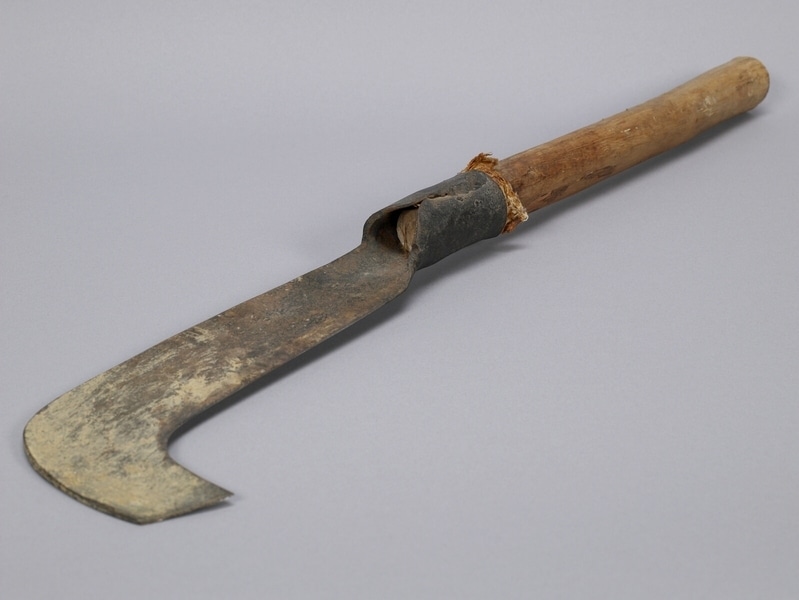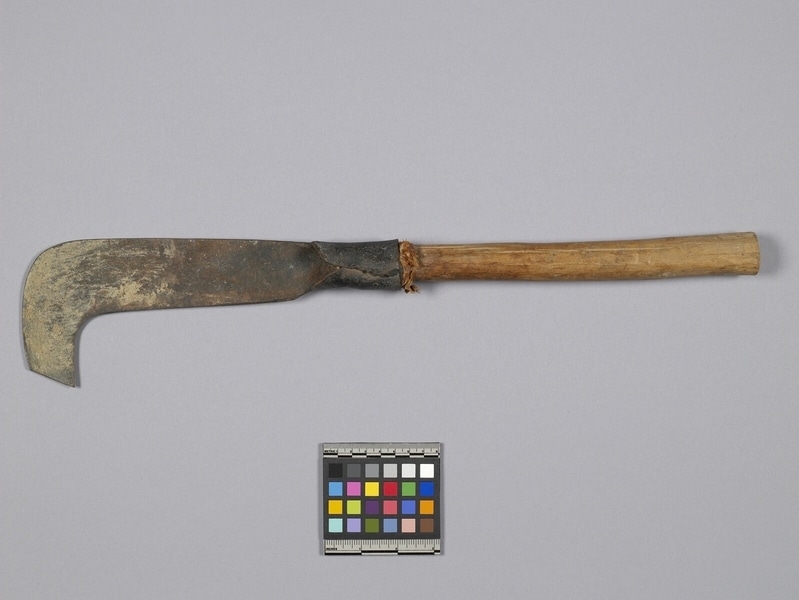Knife Item Number: Edz1107 from the MOA: University of British Columbia


Description
J-shaped metal blade attached to a straight, wooden handle.
History Of Use
Fuel-gathering was an important activity for women in Tsuen Wan District and elsewhere in the New Territories until about the 1950s. The cutting and gathering of bracken (called grass) was done in the dry winter season. Women gathered in groups, often divided by age range, to go up into the hills to cut large amounts of bracken, which was used as fuel for cooking food for people and for pigs. The bracken was used as fuel in the large brick range that each house had. One or two large woks were inserted in holes in the top. Fuel was also sometimes sold if a household had surplus. People with a special need for it were the boat-dwelling fishing people, who owned no land and need to burn it to bream their boats on a regular basis.
Pine branches were another source of fuel. Women used knives like this one to lop branches off pine trees. They would chop them off with the end and then trim them with the blade. The point at the end was used to move logs. This knife was used in conjunction with a special cleaver for splitting wood. After the mid-twentieth century the New Territories of Hong Kong began to undergo fundamental changes. The people who had been settled there before 1898, when the British colonizers claimed the area, began to give up rice agriculture and coastal fishing, turning instead to wage labour and increased employment overseas. By the end of the century, educational opportunities leading to the possibility of white-collar work also increased, together with western influences. Twentieth-century changes meant that objects and clothing once useful and appropriate were no longer needed and generally were discarded. Some were saved by their owners, who sometimes were willing to donate them to museums, sharing, also, their knowledge of how they were made and used.
Narrative
Mrs. Yau Chan, Shek Ying provided detailed information on grass-cutting and fuel gathering in general. She said that the blades of these knives were bought from blacksmiths, while they made the handles themselves. Hakka people are one of the two original land-dwelling groups that settled the area that became the New Territories of Hong Kong. Their spoken language, and some customs, differed from those of the other original group, the Cantonese or Punti. The Cantonese arrived first and settled on the best rice-growing lands, while the Hakka began to arrive after the late 17th century and settled the more hilly lands.
Item History
- Made in Tsuen Wan, Hong Kong, China
- Collected by Elizabeth L. Johnson during 1979
- Owned by Kun-lam Chan
- Owned by Elizabeth L. Johnson before March 17, 1980
- Received from Elizabeth L. Johnson (Seller) and Museum of Anthropology Shop Volunteers (Funding source) on March 17, 1980
What
Who
- Culture
- Chinese: Hakka
- Field Collector
- Elizabeth L. Johnson
- Previous Owner
- Kun-lam Chan and Elizabeth L. Johnson
- Received from
- Elizabeth L. Johnson (Seller) and Museum of Anthropology Shop Volunteers (Funding source)
Where
- Holding Institution
- MOA: University of British Columbia
- Made in
- Tsuen Wan, Hong Kong, China
When
- Collection Date
- during 1979
- Ownership Date
- before March 17, 1980
- Acquisition Date
- on March 17, 1980
Other
- Item Classes
- metalwork
- Condition
- fair
- Accession Number
- 0610/0077